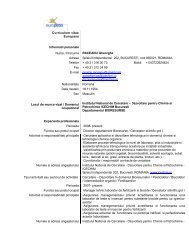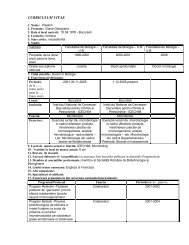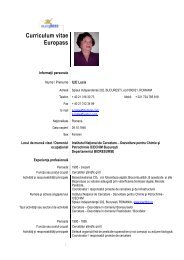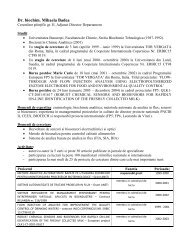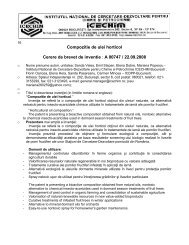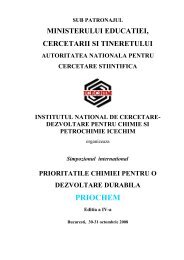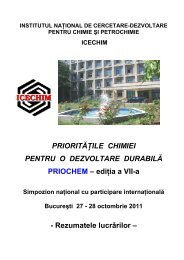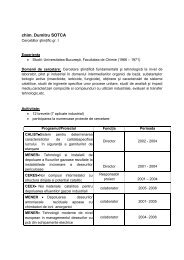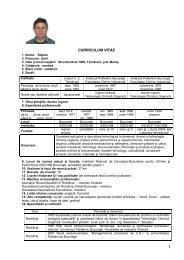INSTITUTUL NAÅ¢IONAL DE CERCETARE-DEZVOLTARE - ICECHIM
INSTITUTUL NAÅ¢IONAL DE CERCETARE-DEZVOLTARE - ICECHIM
INSTITUTUL NAÅ¢IONAL DE CERCETARE-DEZVOLTARE - ICECHIM
- No tags were found...
Create successful ePaper yourself
Turn your PDF publications into a flip-book with our unique Google optimized e-Paper software.
3. Chemistry in medical and pharmaceutical applications - PDISPOSABLE BIOSENSORS FOR <strong>DE</strong>TERMINATION OF DOPAMINEC.V. Popa (Ungureanu) 1 , I.M. Apetrei 2 , D. Tutunaru 2 , C. Apetrei 31 Faculty of Food Science and Engineering, “Dunarea de Jos” University of Galati2 Faculty of Medicine and Pharmacy, “Dunarea de Jos” University of Galati3 Department of Chemistry, Physics and Environment, Faculty of Sciences and Environment,“Dunarea de Jos” University of Galati, 47 Domneasca Street, 800008 Galati, Romania.E-mail: apetreic@ugal.roAbstractDopamine (DA) is one of more important catecholamine neurotransmitters in the centralnervous system of mammals [1], and dopamine biochemistry is assumed to be associated toseveral diseases, such as schizophrenia and Parkinsonism [2]. For that reason, quantifying itspresence in drugs and human body fluids is very important.This work reports tyrosinase (Ty) based biosensors using screen-printed carbonaceous(carbon nanotubes - CNT, carbon nanofibers - CNF, and graphene - GPH) electrodes for thedetermination of DA in pharmaceutical formula. The enzyme was immobilized onto thecarbon working electrode by drop and dry method followed by cross-linking withglutaraldehyde. The detection was performed by measuring the cathodic current due to thereduction of enzymatically formed dopaquinone at a low potential, -0.250V vs Ag/AgClreference electrode. The experimental conditions for the tyrosinase immobilization, as well asfor the main variables that can influence the amperometric current were optimized. Underthese optimum conditions, the disposable biosensors were characterized. The capability ofdetection was ranged between 0.24 M and 4.3 M for novel developed biosensors. Finally,the biosensors were applied to the determination of the dopamine in pharmaceutical formula.AcknowledgmentsThis work was supported by a grant of the Romanian National Authority for ScientificResearch, CNCS – UEFISCDI, project number PN-II-ID-PCE-2011-3-0255.References1. Zhang, D. Q.; Wong, K. Y.; Berson, D. M.; Sollars, P. J.; Pickard, G. E.; McMahon, D. G.Proc. Natl. Acad. Sci. U.S.A. 2008, 105, 14181-14186.2. Merims, D.; Giladi, N. Parkinsonism Rel. Disord. 2008, 14, 273-80.




